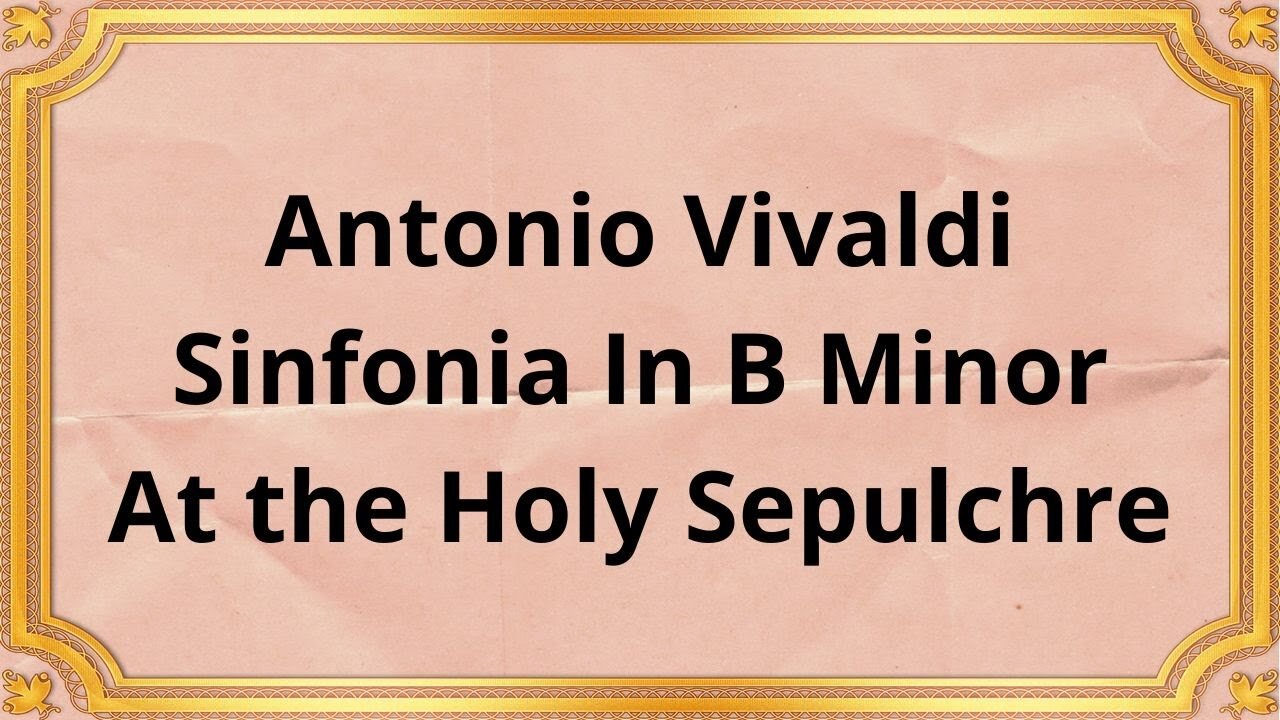Premium Only Content

Antonio Vivaldi Sinfonia In B Minor At the Holy Sepulchre
#AntonioVivaldi #ClassicalMusic #SinfoniaInBMinor #HolySepulchre #BaroqueComposer #MusicComposition #ItalianComposer #Orchestra #ClassicalInstruments #MusicalMasterpiece
Orchestra "Alessandro Scarlatti" of Naples of the RAI;
conducted Thomas Schippers
Antonio Vivaldi, an influential Italian composer of the Baroque era, has left an indelible mark on the world of classical music. One of his lesser-known yet remarkable compositions is the "Sinfonia In B Minor At the Holy Sepulchre."
The "Sinfonia In B Minor At the Holy Sepulchre" was composed by Antonio Vivaldi in the early 18th century. During this time, Vivaldi served as the maestro di violino at the Ospedale della Pietà, a renowned music school and orphanage in Venice. The composition of this sinfonia coincided with Vivaldi's prolific period, during which he composed numerous concertos, sonatas, and sacred works.
The sinfonia is structured in three movements, adhering to the traditional fast-slow-fast sequence typical of Baroque instrumental compositions. It begins with a lively and energetic Allegro, showcasing Vivaldi's mastery of counterpoint and intricate melodic lines. The second movement, marked Adagio, offers a moment of tranquility with its gentle and expressive melodies. Finally, the sinfonia concludes with a spirited Allegro, characterized by virtuosic passages and vibrant orchestration.
The instrumentation of the sinfonia showcases Vivaldi's affinity for orchestral writing. It typically employs a string orchestra accompanied by a continuo, consisting of harpsichord and cello. The interplay between the different sections of the orchestra creates a rich tapestry of sound, with each instrument adding its unique voice to the composition.
The "Sinfonia In B Minor At the Holy Sepulchre" holds historical and cultural significance. It was primarily composed for performance during religious ceremonies at the Holy Sepulchre, a significant site in Jerusalem associated with the crucifixion and burial of Jesus Christ. This connection to sacred spaces adds a spiritual dimension to the composition, heightening its emotional impact.
Furthermore, this sinfonia exemplifies Vivaldi's innovative approach to composition. His use of contrasting dynamics, bold harmonies, and intricate ornamentation showcases his unrivaled skill as a composer. The sinfonia's blend of technical virtuosity and expressive melodies captivates listeners, making it a valuable addition to the repertoire of Baroque music.
Conclusion:
Antonio Vivaldi's "Sinfonia In B Minor At the Holy Sepulchre" stands as a testament to the composer's genius and mastery of the Baroque style. Its historical significance, musical elements, and emotional depth make it a truly remarkable piece of music. Through this sinfonia, Vivaldi's legacy continues to resonate, captivating audiences and reminding us of the enduring power of classical music.
You have the opportunity to support the channel:
https://destream.net/live/RadSiarAl/donate
https://www.buymeacoffee.com/6355radsiaral
-
 58:34
58:34
Rethinking the Dollar
21 hours agoTrump Faces 'Big Mess' Ahead | RTD News Update
40.8K5 -
 5:35
5:35
Dermatologist Dr. Dustin Portela
21 hours ago $1.95 earnedUnboxing Neutrogena PR Box: Skincare Products and Surprises!
40.5K4 -
 11:20
11:20
China Uncensored
21 hours agoCan the US Exploit a Rift Between China and Russia?
64.2K21 -
 2:08:48
2:08:48
TheSaltyCracker
16 hours agoLefty Grifters Go MAGA ReeEEeE Stream 12-22-24
262K701 -
 1:15:40
1:15:40
Man in America
19 hours agoThe DISTURBING Truth: How Seed Oils, the Vatican, and Procter & Gamble Are Connected w/ Dan Lyons
154K135 -
 6:46:07
6:46:07
Rance's Gaming Corner
20 hours agoTime for some RUMBLE FPS!! Get in here.. w/Fragniac
177K5 -
 1:30:48
1:30:48
Josh Pate's College Football Show
20 hours ago $11.42 earnedCFP Reaction Special | Early Quarterfinal Thoughts | Transfer Portal Intel | Fixing The Playoff
108K1 -
 23:55
23:55
CartierFamily
3 days agoElon & Vivek TRIGGER Congress as DOGE SHUTS DOWN Government
145K162 -
 5:43:44
5:43:44
Scammer Payback
2 days agoCalling Scammers Live
235K30 -
 18:38
18:38
VSiNLive
2 days agoProfessional Gambler Steve Fezzik LOVES this UNDERVALUED Point Spread!
169K20